Money Laundering Law: Analysis of EU, UK, and Global Efforts
VerifiedAdded on 2021/06/17
|18
|3985
|169
Report
AI Summary
This report provides a comprehensive overview of money laundering laws, examining the various facets of this critical issue. It begins with an introduction to money laundering, defining the process and its implications, including its links to terrorist financing. The report then delves into the role of the Financial Action Task Force (FATF) and explores money laundering as an organized crime, discussing its impact on market abuse. It analyzes the efforts of international institutions in combating money laundering and examines the EU's Anti-Money Laundering Directives, including their evolution and challenges. The report also discusses the implementation of money laundering laws in the UK, considering the impact of Brexit. It concludes by highlighting the shortcomings of the current regulations and emphasizing the need for continuous efforts to combat money laundering effectively.
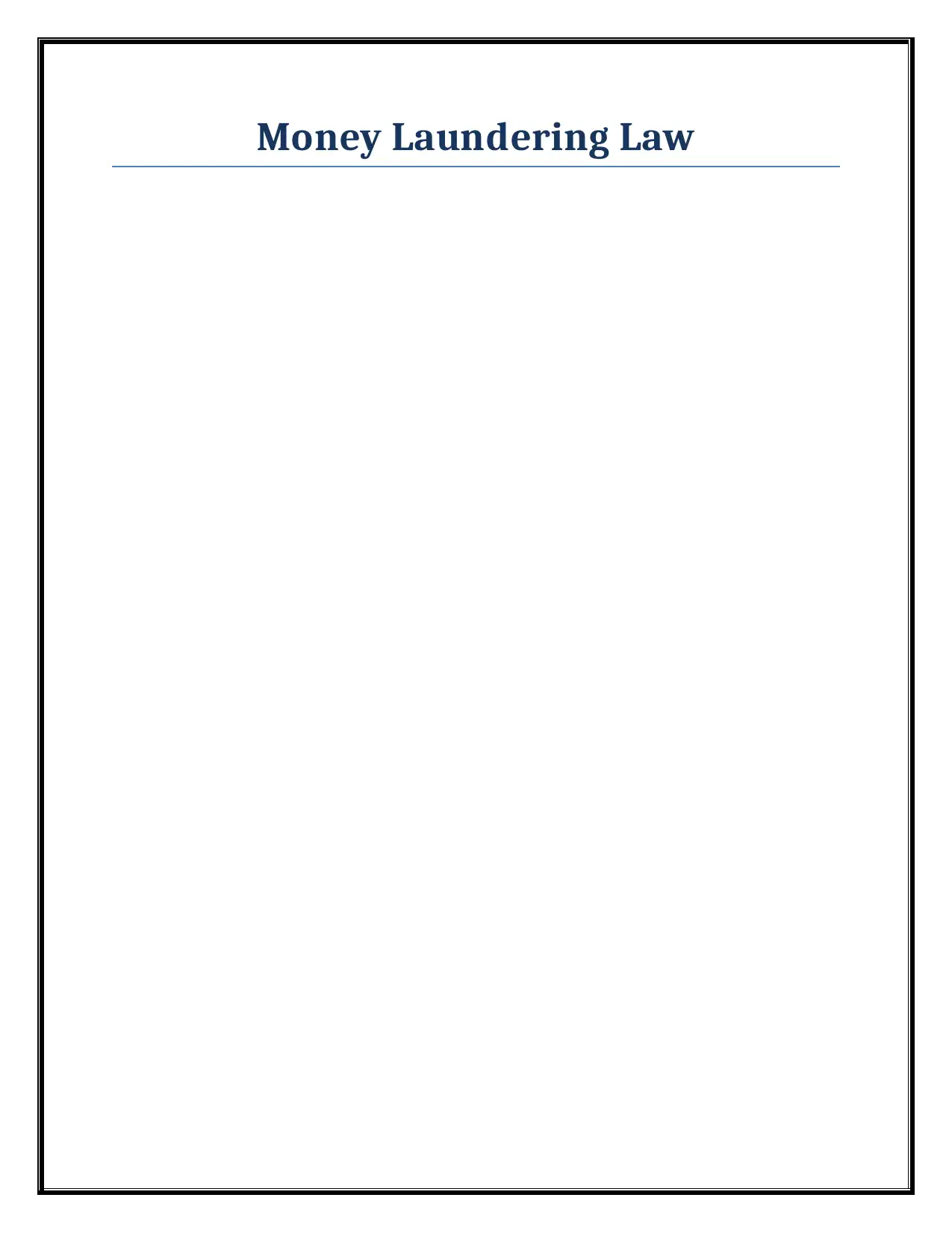
Money Laundering Law
Paraphrase This Document
Need a fresh take? Get an instant paraphrase of this document with our AI Paraphraser
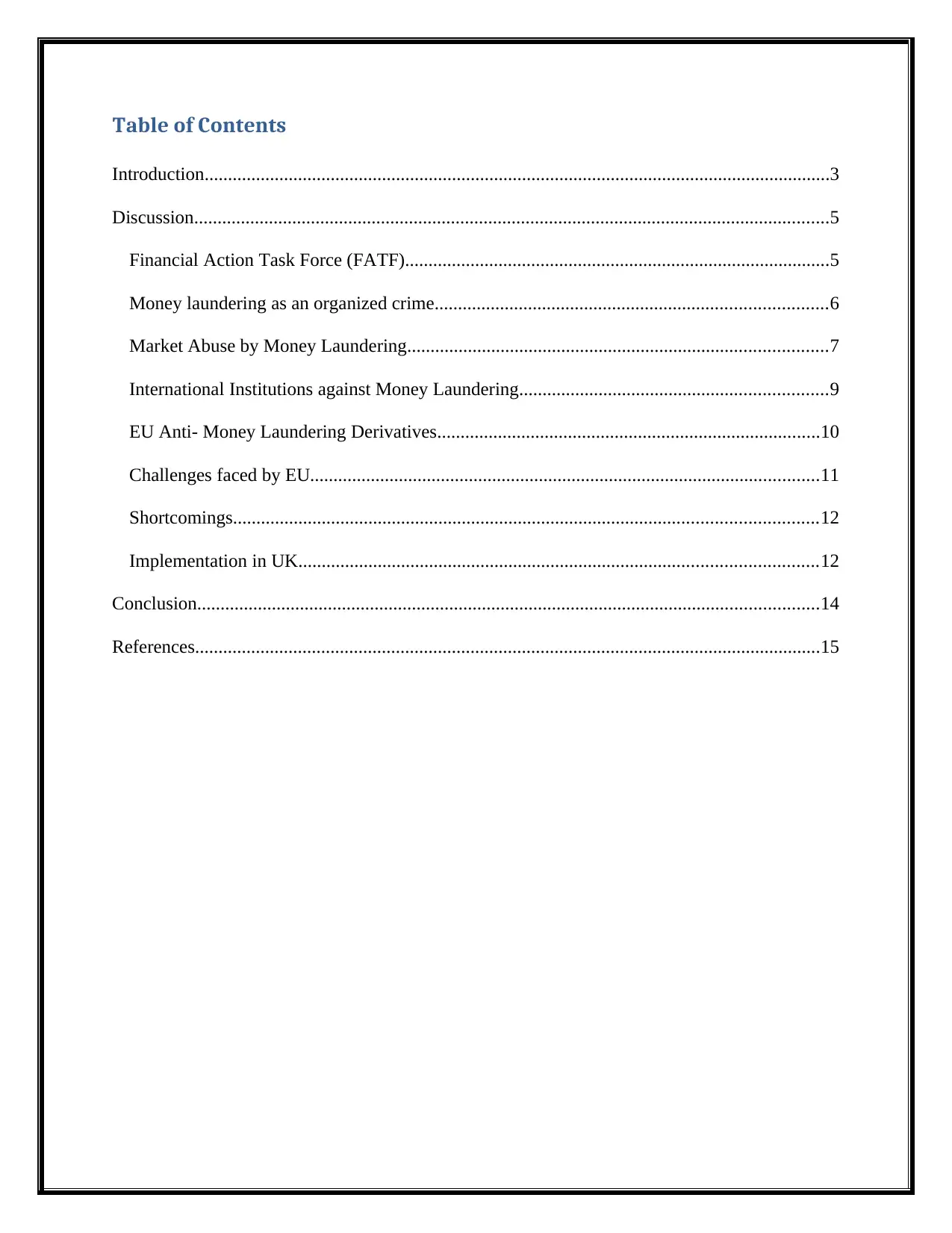
Table of Contents
Introduction......................................................................................................................................3
Discussion........................................................................................................................................5
Financial Action Task Force (FATF)...........................................................................................5
Money laundering as an organized crime....................................................................................6
Market Abuse by Money Laundering..........................................................................................7
International Institutions against Money Laundering..................................................................9
EU Anti- Money Laundering Derivatives..................................................................................10
Challenges faced by EU.............................................................................................................11
Shortcomings.............................................................................................................................12
Implementation in UK...............................................................................................................12
Conclusion.....................................................................................................................................14
References......................................................................................................................................15
Introduction......................................................................................................................................3
Discussion........................................................................................................................................5
Financial Action Task Force (FATF)...........................................................................................5
Money laundering as an organized crime....................................................................................6
Market Abuse by Money Laundering..........................................................................................7
International Institutions against Money Laundering..................................................................9
EU Anti- Money Laundering Derivatives..................................................................................10
Challenges faced by EU.............................................................................................................11
Shortcomings.............................................................................................................................12
Implementation in UK...............................................................................................................12
Conclusion.....................................................................................................................................14
References......................................................................................................................................15
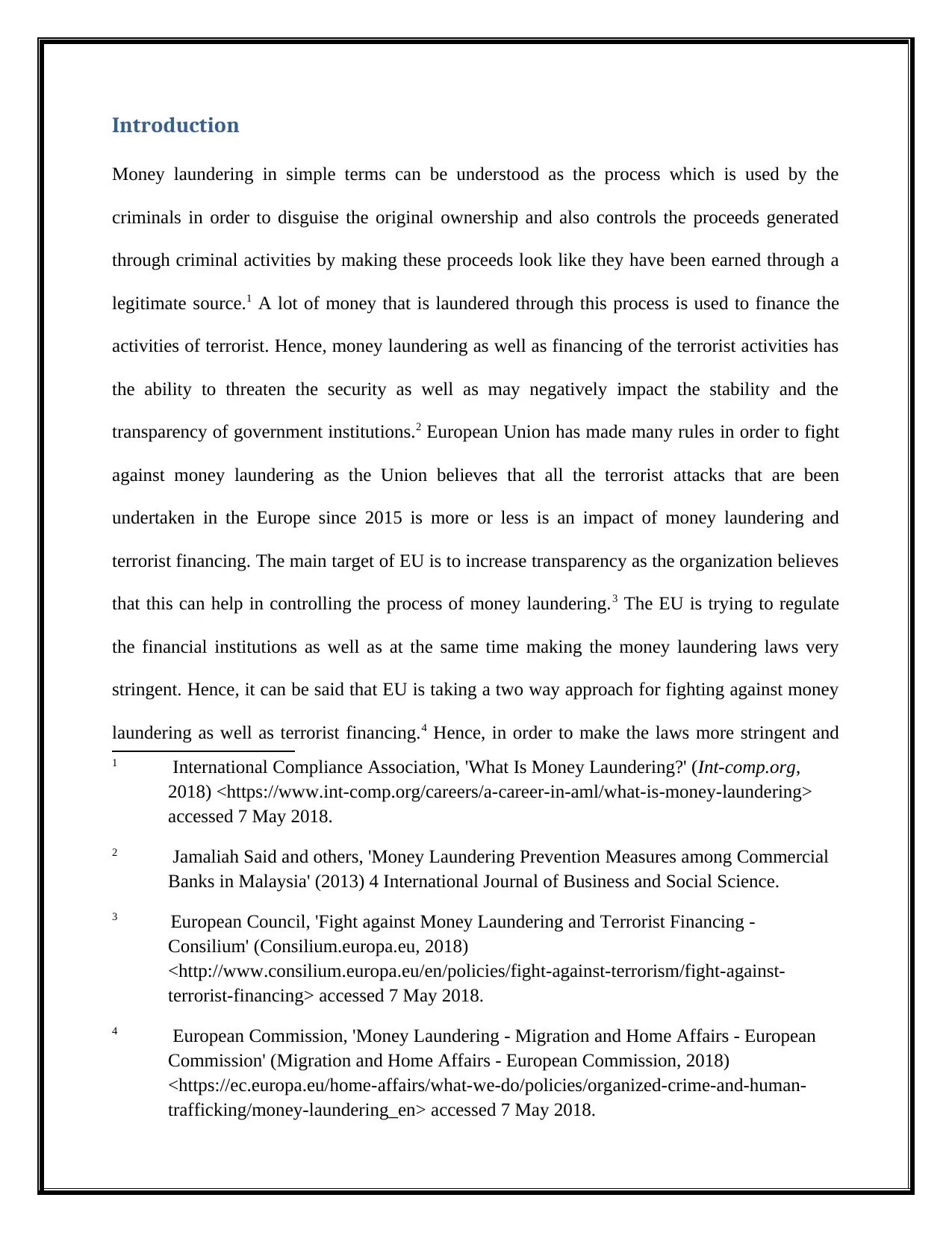
Introduction
Money laundering in simple terms can be understood as the process which is used by the
criminals in order to disguise the original ownership and also controls the proceeds generated
through criminal activities by making these proceeds look like they have been earned through a
legitimate source.1 A lot of money that is laundered through this process is used to finance the
activities of terrorist. Hence, money laundering as well as financing of the terrorist activities has
the ability to threaten the security as well as may negatively impact the stability and the
transparency of government institutions.2 European Union has made many rules in order to fight
against money laundering as the Union believes that all the terrorist attacks that are been
undertaken in the Europe since 2015 is more or less is an impact of money laundering and
terrorist financing. The main target of EU is to increase transparency as the organization believes
that this can help in controlling the process of money laundering.3 The EU is trying to regulate
the financial institutions as well as at the same time making the money laundering laws very
stringent. Hence, it can be said that EU is taking a two way approach for fighting against money
laundering as well as terrorist financing.4 Hence, in order to make the laws more stringent and
1 International Compliance Association, 'What Is Money Laundering?' (Int-comp.org,
2018) <https://www.int-comp.org/careers/a-career-in-aml/what-is-money-laundering>
accessed 7 May 2018.
2 Jamaliah Said and others, 'Money Laundering Prevention Measures among Commercial
Banks in Malaysia' (2013) 4 International Journal of Business and Social Science.
3 European Council, 'Fight against Money Laundering and Terrorist Financing -
Consilium' (Consilium.europa.eu, 2018)
<http://www.consilium.europa.eu/en/policies/fight-against-terrorism/fight-against-
terrorist-financing> accessed 7 May 2018.
4 European Commission, 'Money Laundering - Migration and Home Affairs - European
Commission' (Migration and Home Affairs - European Commission, 2018)
<https://ec.europa.eu/home-affairs/what-we-do/policies/organized-crime-and-human-
trafficking/money-laundering_en> accessed 7 May 2018.
Money laundering in simple terms can be understood as the process which is used by the
criminals in order to disguise the original ownership and also controls the proceeds generated
through criminal activities by making these proceeds look like they have been earned through a
legitimate source.1 A lot of money that is laundered through this process is used to finance the
activities of terrorist. Hence, money laundering as well as financing of the terrorist activities has
the ability to threaten the security as well as may negatively impact the stability and the
transparency of government institutions.2 European Union has made many rules in order to fight
against money laundering as the Union believes that all the terrorist attacks that are been
undertaken in the Europe since 2015 is more or less is an impact of money laundering and
terrorist financing. The main target of EU is to increase transparency as the organization believes
that this can help in controlling the process of money laundering.3 The EU is trying to regulate
the financial institutions as well as at the same time making the money laundering laws very
stringent. Hence, it can be said that EU is taking a two way approach for fighting against money
laundering as well as terrorist financing.4 Hence, in order to make the laws more stringent and
1 International Compliance Association, 'What Is Money Laundering?' (Int-comp.org,
2018) <https://www.int-comp.org/careers/a-career-in-aml/what-is-money-laundering>
accessed 7 May 2018.
2 Jamaliah Said and others, 'Money Laundering Prevention Measures among Commercial
Banks in Malaysia' (2013) 4 International Journal of Business and Social Science.
3 European Council, 'Fight against Money Laundering and Terrorist Financing -
Consilium' (Consilium.europa.eu, 2018)
<http://www.consilium.europa.eu/en/policies/fight-against-terrorism/fight-against-
terrorist-financing> accessed 7 May 2018.
4 European Commission, 'Money Laundering - Migration and Home Affairs - European
Commission' (Migration and Home Affairs - European Commission, 2018)
<https://ec.europa.eu/home-affairs/what-we-do/policies/organized-crime-and-human-
trafficking/money-laundering_en> accessed 7 May 2018.
⊘ This is a preview!⊘
Do you want full access?
Subscribe today to unlock all pages.

Trusted by 1+ million students worldwide
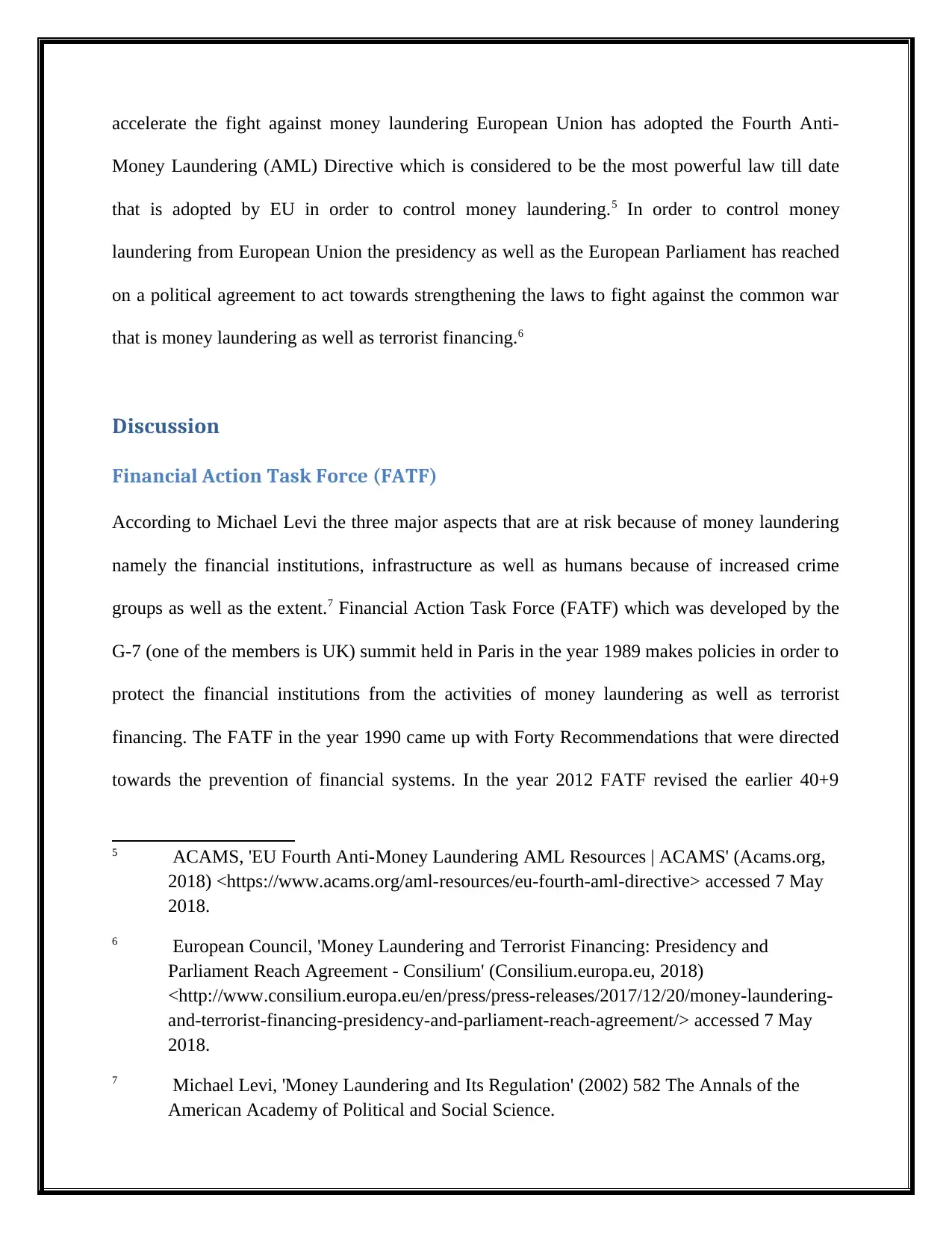
accelerate the fight against money laundering European Union has adopted the Fourth Anti-
Money Laundering (AML) Directive which is considered to be the most powerful law till date
that is adopted by EU in order to control money laundering.5 In order to control money
laundering from European Union the presidency as well as the European Parliament has reached
on a political agreement to act towards strengthening the laws to fight against the common war
that is money laundering as well as terrorist financing.6
Discussion
Financial Action Task Force (FATF)
According to Michael Levi the three major aspects that are at risk because of money laundering
namely the financial institutions, infrastructure as well as humans because of increased crime
groups as well as the extent.7 Financial Action Task Force (FATF) which was developed by the
G-7 (one of the members is UK) summit held in Paris in the year 1989 makes policies in order to
protect the financial institutions from the activities of money laundering as well as terrorist
financing. The FATF in the year 1990 came up with Forty Recommendations that were directed
towards the prevention of financial systems. In the year 2012 FATF revised the earlier 40+9
5 ACAMS, 'EU Fourth Anti-Money Laundering AML Resources | ACAMS' (Acams.org,
2018) <https://www.acams.org/aml-resources/eu-fourth-aml-directive> accessed 7 May
2018.
6 European Council, 'Money Laundering and Terrorist Financing: Presidency and
Parliament Reach Agreement - Consilium' (Consilium.europa.eu, 2018)
<http://www.consilium.europa.eu/en/press/press-releases/2017/12/20/money-laundering-
and-terrorist-financing-presidency-and-parliament-reach-agreement/> accessed 7 May
2018.
7 Michael Levi, 'Money Laundering and Its Regulation' (2002) 582 The Annals of the
American Academy of Political and Social Science.
Money Laundering (AML) Directive which is considered to be the most powerful law till date
that is adopted by EU in order to control money laundering.5 In order to control money
laundering from European Union the presidency as well as the European Parliament has reached
on a political agreement to act towards strengthening the laws to fight against the common war
that is money laundering as well as terrorist financing.6
Discussion
Financial Action Task Force (FATF)
According to Michael Levi the three major aspects that are at risk because of money laundering
namely the financial institutions, infrastructure as well as humans because of increased crime
groups as well as the extent.7 Financial Action Task Force (FATF) which was developed by the
G-7 (one of the members is UK) summit held in Paris in the year 1989 makes policies in order to
protect the financial institutions from the activities of money laundering as well as terrorist
financing. The FATF in the year 1990 came up with Forty Recommendations that were directed
towards the prevention of financial systems. In the year 2012 FATF revised the earlier 40+9
5 ACAMS, 'EU Fourth Anti-Money Laundering AML Resources | ACAMS' (Acams.org,
2018) <https://www.acams.org/aml-resources/eu-fourth-aml-directive> accessed 7 May
2018.
6 European Council, 'Money Laundering and Terrorist Financing: Presidency and
Parliament Reach Agreement - Consilium' (Consilium.europa.eu, 2018)
<http://www.consilium.europa.eu/en/press/press-releases/2017/12/20/money-laundering-
and-terrorist-financing-presidency-and-parliament-reach-agreement/> accessed 7 May
2018.
7 Michael Levi, 'Money Laundering and Its Regulation' (2002) 582 The Annals of the
American Academy of Political and Social Science.
Paraphrase This Document
Need a fresh take? Get an instant paraphrase of this document with our AI Paraphraser
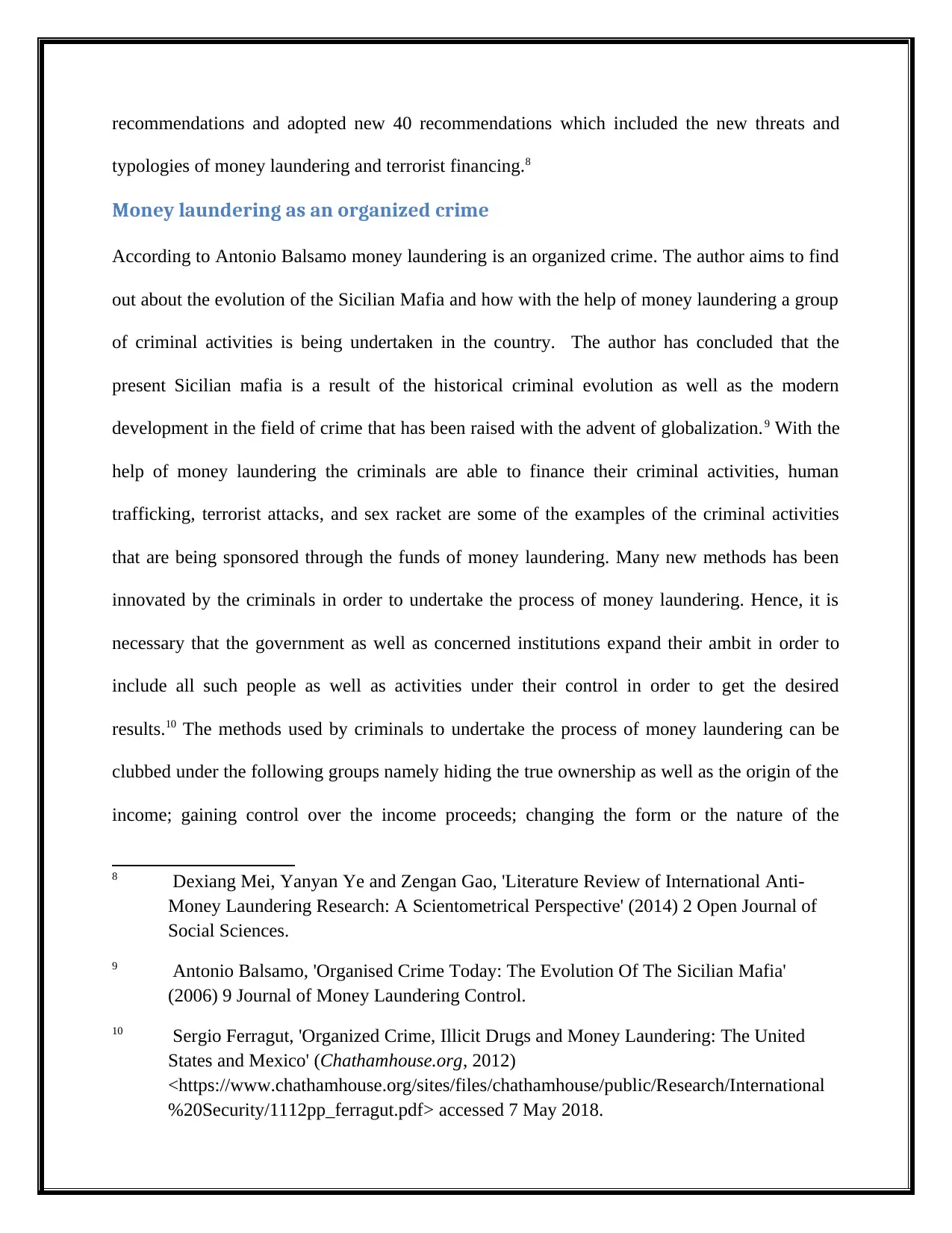
recommendations and adopted new 40 recommendations which included the new threats and
typologies of money laundering and terrorist financing.8
Money laundering as an organized crime
According to Antonio Balsamo money laundering is an organized crime. The author aims to find
out about the evolution of the Sicilian Mafia and how with the help of money laundering a group
of criminal activities is being undertaken in the country. The author has concluded that the
present Sicilian mafia is a result of the historical criminal evolution as well as the modern
development in the field of crime that has been raised with the advent of globalization.9 With the
help of money laundering the criminals are able to finance their criminal activities, human
trafficking, terrorist attacks, and sex racket are some of the examples of the criminal activities
that are being sponsored through the funds of money laundering. Many new methods has been
innovated by the criminals in order to undertake the process of money laundering. Hence, it is
necessary that the government as well as concerned institutions expand their ambit in order to
include all such people as well as activities under their control in order to get the desired
results.10 The methods used by criminals to undertake the process of money laundering can be
clubbed under the following groups namely hiding the true ownership as well as the origin of the
income; gaining control over the income proceeds; changing the form or the nature of the
8 Dexiang Mei, Yanyan Ye and Zengan Gao, 'Literature Review of International Anti-
Money Laundering Research: A Scientometrical Perspective' (2014) 2 Open Journal of
Social Sciences.
9 Antonio Balsamo, 'Organised Crime Today: The Evolution Of The Sicilian Mafia'
(2006) 9 Journal of Money Laundering Control.
10 Sergio Ferragut, 'Organized Crime, Illicit Drugs and Money Laundering: The United
States and Mexico' (Chathamhouse.org, 2012)
<https://www.chathamhouse.org/sites/files/chathamhouse/public/Research/International
%20Security/1112pp_ferragut.pdf> accessed 7 May 2018.
typologies of money laundering and terrorist financing.8
Money laundering as an organized crime
According to Antonio Balsamo money laundering is an organized crime. The author aims to find
out about the evolution of the Sicilian Mafia and how with the help of money laundering a group
of criminal activities is being undertaken in the country. The author has concluded that the
present Sicilian mafia is a result of the historical criminal evolution as well as the modern
development in the field of crime that has been raised with the advent of globalization.9 With the
help of money laundering the criminals are able to finance their criminal activities, human
trafficking, terrorist attacks, and sex racket are some of the examples of the criminal activities
that are being sponsored through the funds of money laundering. Many new methods has been
innovated by the criminals in order to undertake the process of money laundering. Hence, it is
necessary that the government as well as concerned institutions expand their ambit in order to
include all such people as well as activities under their control in order to get the desired
results.10 The methods used by criminals to undertake the process of money laundering can be
clubbed under the following groups namely hiding the true ownership as well as the origin of the
income; gaining control over the income proceeds; changing the form or the nature of the
8 Dexiang Mei, Yanyan Ye and Zengan Gao, 'Literature Review of International Anti-
Money Laundering Research: A Scientometrical Perspective' (2014) 2 Open Journal of
Social Sciences.
9 Antonio Balsamo, 'Organised Crime Today: The Evolution Of The Sicilian Mafia'
(2006) 9 Journal of Money Laundering Control.
10 Sergio Ferragut, 'Organized Crime, Illicit Drugs and Money Laundering: The United
States and Mexico' (Chathamhouse.org, 2012)
<https://www.chathamhouse.org/sites/files/chathamhouse/public/Research/International
%20Security/1112pp_ferragut.pdf> accessed 7 May 2018.
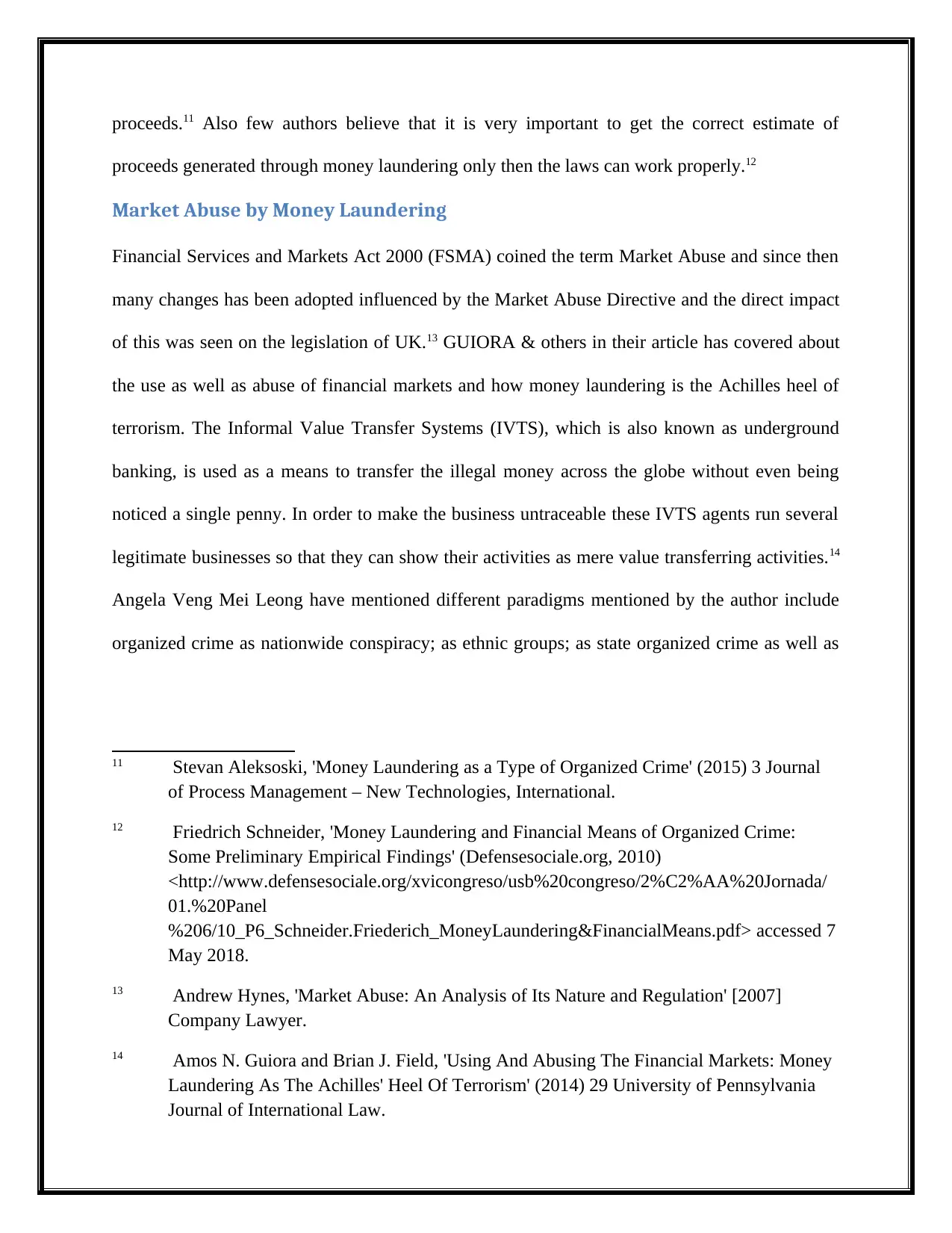
proceeds.11 Also few authors believe that it is very important to get the correct estimate of
proceeds generated through money laundering only then the laws can work properly.12
Market Abuse by Money Laundering
Financial Services and Markets Act 2000 (FSMA) coined the term Market Abuse and since then
many changes has been adopted influenced by the Market Abuse Directive and the direct impact
of this was seen on the legislation of UK.13 GUIORA & others in their article has covered about
the use as well as abuse of financial markets and how money laundering is the Achilles heel of
terrorism. The Informal Value Transfer Systems (IVTS), which is also known as underground
banking, is used as a means to transfer the illegal money across the globe without even being
noticed a single penny. In order to make the business untraceable these IVTS agents run several
legitimate businesses so that they can show their activities as mere value transferring activities.14
Angela Veng Mei Leong have mentioned different paradigms mentioned by the author include
organized crime as nationwide conspiracy; as ethnic groups; as state organized crime as well as
11 Stevan Aleksoski, 'Money Laundering as a Type of Organized Crime' (2015) 3 Journal
of Process Management – New Technologies, International.
12 Friedrich Schneider, 'Money Laundering and Financial Means of Organized Crime:
Some Preliminary Empirical Findings' (Defensesociale.org, 2010)
<http://www.defensesociale.org/xvicongreso/usb%20congreso/2%C2%AA%20Jornada/
01.%20Panel
%206/10_P6_Schneider.Friederich_MoneyLaundering&FinancialMeans.pdf> accessed 7
May 2018.
13 Andrew Hynes, 'Market Abuse: An Analysis of Its Nature and Regulation' [2007]
Company Lawyer.
14 Amos N. Guiora and Brian J. Field, 'Using And Abusing The Financial Markets: Money
Laundering As The Achilles' Heel Of Terrorism' (2014) 29 University of Pennsylvania
Journal of International Law.
proceeds generated through money laundering only then the laws can work properly.12
Market Abuse by Money Laundering
Financial Services and Markets Act 2000 (FSMA) coined the term Market Abuse and since then
many changes has been adopted influenced by the Market Abuse Directive and the direct impact
of this was seen on the legislation of UK.13 GUIORA & others in their article has covered about
the use as well as abuse of financial markets and how money laundering is the Achilles heel of
terrorism. The Informal Value Transfer Systems (IVTS), which is also known as underground
banking, is used as a means to transfer the illegal money across the globe without even being
noticed a single penny. In order to make the business untraceable these IVTS agents run several
legitimate businesses so that they can show their activities as mere value transferring activities.14
Angela Veng Mei Leong have mentioned different paradigms mentioned by the author include
organized crime as nationwide conspiracy; as ethnic groups; as state organized crime as well as
11 Stevan Aleksoski, 'Money Laundering as a Type of Organized Crime' (2015) 3 Journal
of Process Management – New Technologies, International.
12 Friedrich Schneider, 'Money Laundering and Financial Means of Organized Crime:
Some Preliminary Empirical Findings' (Defensesociale.org, 2010)
<http://www.defensesociale.org/xvicongreso/usb%20congreso/2%C2%AA%20Jornada/
01.%20Panel
%206/10_P6_Schneider.Friederich_MoneyLaundering&FinancialMeans.pdf> accessed 7
May 2018.
13 Andrew Hynes, 'Market Abuse: An Analysis of Its Nature and Regulation' [2007]
Company Lawyer.
14 Amos N. Guiora and Brian J. Field, 'Using And Abusing The Financial Markets: Money
Laundering As The Achilles' Heel Of Terrorism' (2014) 29 University of Pennsylvania
Journal of International Law.
⊘ This is a preview!⊘
Do you want full access?
Subscribe today to unlock all pages.

Trusted by 1+ million students worldwide
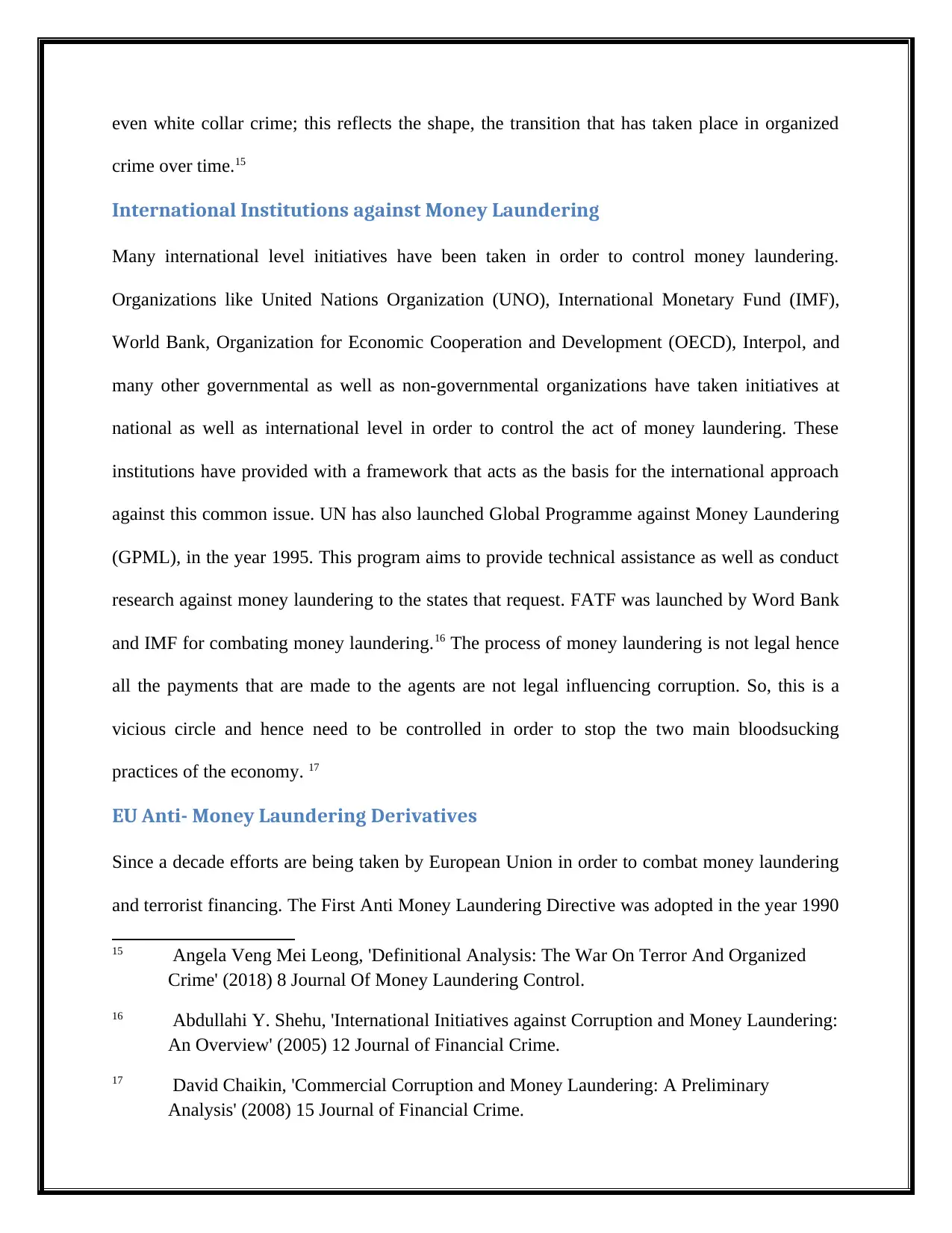
even white collar crime; this reflects the shape, the transition that has taken place in organized
crime over time.15
International Institutions against Money Laundering
Many international level initiatives have been taken in order to control money laundering.
Organizations like United Nations Organization (UNO), International Monetary Fund (IMF),
World Bank, Organization for Economic Cooperation and Development (OECD), Interpol, and
many other governmental as well as non-governmental organizations have taken initiatives at
national as well as international level in order to control the act of money laundering. These
institutions have provided with a framework that acts as the basis for the international approach
against this common issue. UN has also launched Global Programme against Money Laundering
(GPML), in the year 1995. This program aims to provide technical assistance as well as conduct
research against money laundering to the states that request. FATF was launched by Word Bank
and IMF for combating money laundering.16 The process of money laundering is not legal hence
all the payments that are made to the agents are not legal influencing corruption. So, this is a
vicious circle and hence need to be controlled in order to stop the two main bloodsucking
practices of the economy. 17
EU Anti- Money Laundering Derivatives
Since a decade efforts are being taken by European Union in order to combat money laundering
and terrorist financing. The First Anti Money Laundering Directive was adopted in the year 1990
15 Angela Veng Mei Leong, 'Definitional Analysis: The War On Terror And Organized
Crime' (2018) 8 Journal Of Money Laundering Control.
16 Abdullahi Y. Shehu, 'International Initiatives against Corruption and Money Laundering:
An Overview' (2005) 12 Journal of Financial Crime.
17 David Chaikin, 'Commercial Corruption and Money Laundering: A Preliminary
Analysis' (2008) 15 Journal of Financial Crime.
crime over time.15
International Institutions against Money Laundering
Many international level initiatives have been taken in order to control money laundering.
Organizations like United Nations Organization (UNO), International Monetary Fund (IMF),
World Bank, Organization for Economic Cooperation and Development (OECD), Interpol, and
many other governmental as well as non-governmental organizations have taken initiatives at
national as well as international level in order to control the act of money laundering. These
institutions have provided with a framework that acts as the basis for the international approach
against this common issue. UN has also launched Global Programme against Money Laundering
(GPML), in the year 1995. This program aims to provide technical assistance as well as conduct
research against money laundering to the states that request. FATF was launched by Word Bank
and IMF for combating money laundering.16 The process of money laundering is not legal hence
all the payments that are made to the agents are not legal influencing corruption. So, this is a
vicious circle and hence need to be controlled in order to stop the two main bloodsucking
practices of the economy. 17
EU Anti- Money Laundering Derivatives
Since a decade efforts are being taken by European Union in order to combat money laundering
and terrorist financing. The First Anti Money Laundering Directive was adopted in the year 1990
15 Angela Veng Mei Leong, 'Definitional Analysis: The War On Terror And Organized
Crime' (2018) 8 Journal Of Money Laundering Control.
16 Abdullahi Y. Shehu, 'International Initiatives against Corruption and Money Laundering:
An Overview' (2005) 12 Journal of Financial Crime.
17 David Chaikin, 'Commercial Corruption and Money Laundering: A Preliminary
Analysis' (2008) 15 Journal of Financial Crime.
Paraphrase This Document
Need a fresh take? Get an instant paraphrase of this document with our AI Paraphraser
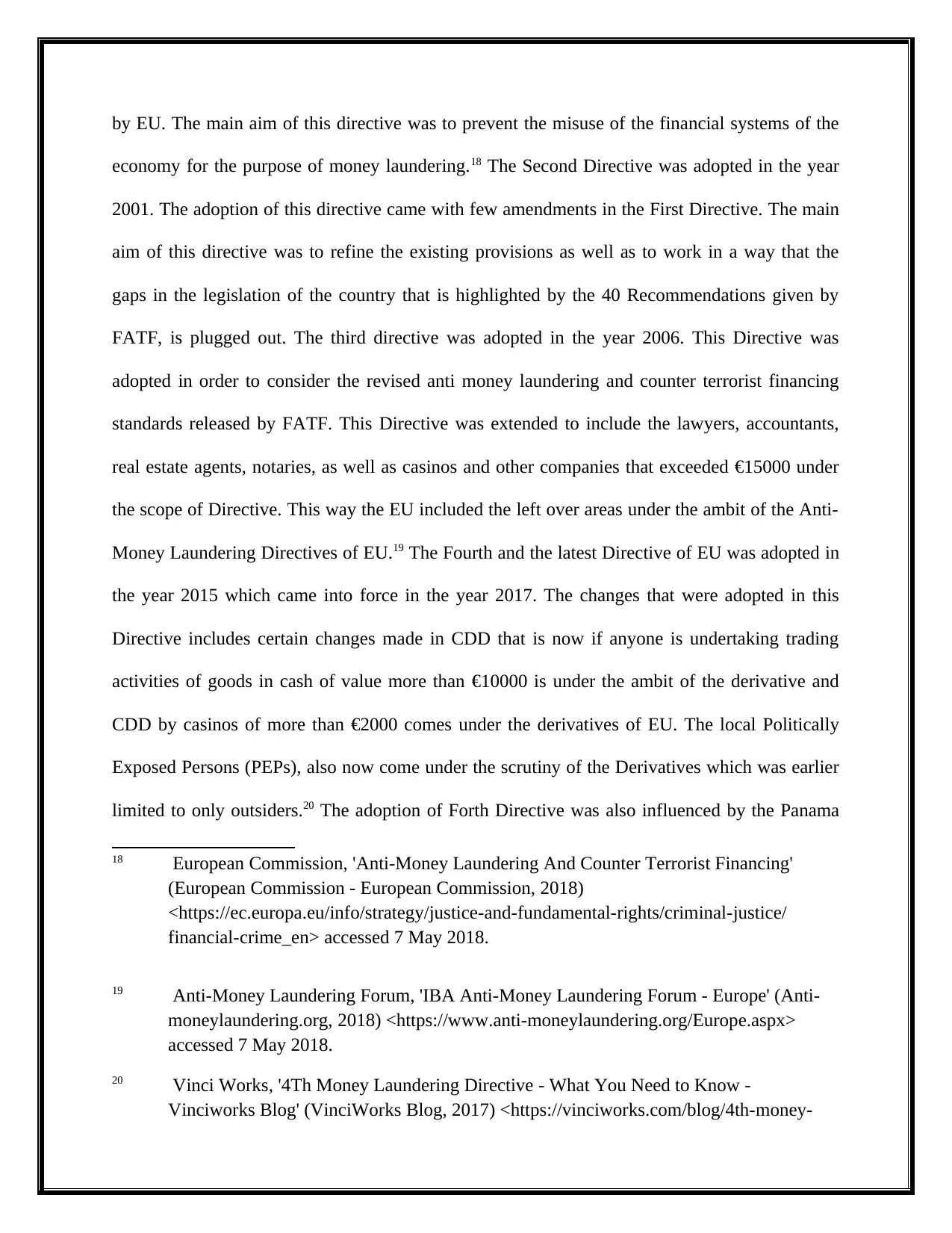
by EU. The main aim of this directive was to prevent the misuse of the financial systems of the
economy for the purpose of money laundering.18 The Second Directive was adopted in the year
2001. The adoption of this directive came with few amendments in the First Directive. The main
aim of this directive was to refine the existing provisions as well as to work in a way that the
gaps in the legislation of the country that is highlighted by the 40 Recommendations given by
FATF, is plugged out. The third directive was adopted in the year 2006. This Directive was
adopted in order to consider the revised anti money laundering and counter terrorist financing
standards released by FATF. This Directive was extended to include the lawyers, accountants,
real estate agents, notaries, as well as casinos and other companies that exceeded €15000 under
the scope of Directive. This way the EU included the left over areas under the ambit of the Anti-
Money Laundering Directives of EU.19 The Fourth and the latest Directive of EU was adopted in
the year 2015 which came into force in the year 2017. The changes that were adopted in this
Directive includes certain changes made in CDD that is now if anyone is undertaking trading
activities of goods in cash of value more than €10000 is under the ambit of the derivative and
CDD by casinos of more than €2000 comes under the derivatives of EU. The local Politically
Exposed Persons (PEPs), also now come under the scrutiny of the Derivatives which was earlier
limited to only outsiders.20 The adoption of Forth Directive was also influenced by the Panama
18 European Commission, 'Anti-Money Laundering And Counter Terrorist Financing'
(European Commission - European Commission, 2018)
<https://ec.europa.eu/info/strategy/justice-and-fundamental-rights/criminal-justice/
financial-crime_en> accessed 7 May 2018.
19 Anti-Money Laundering Forum, 'IBA Anti-Money Laundering Forum - Europe' (Anti-
moneylaundering.org, 2018) <https://www.anti-moneylaundering.org/Europe.aspx>
accessed 7 May 2018.
20 Vinci Works, '4Th Money Laundering Directive - What You Need to Know -
Vinciworks Blog' (VinciWorks Blog, 2017) <https://vinciworks.com/blog/4th-money-
economy for the purpose of money laundering.18 The Second Directive was adopted in the year
2001. The adoption of this directive came with few amendments in the First Directive. The main
aim of this directive was to refine the existing provisions as well as to work in a way that the
gaps in the legislation of the country that is highlighted by the 40 Recommendations given by
FATF, is plugged out. The third directive was adopted in the year 2006. This Directive was
adopted in order to consider the revised anti money laundering and counter terrorist financing
standards released by FATF. This Directive was extended to include the lawyers, accountants,
real estate agents, notaries, as well as casinos and other companies that exceeded €15000 under
the scope of Directive. This way the EU included the left over areas under the ambit of the Anti-
Money Laundering Directives of EU.19 The Fourth and the latest Directive of EU was adopted in
the year 2015 which came into force in the year 2017. The changes that were adopted in this
Directive includes certain changes made in CDD that is now if anyone is undertaking trading
activities of goods in cash of value more than €10000 is under the ambit of the derivative and
CDD by casinos of more than €2000 comes under the derivatives of EU. The local Politically
Exposed Persons (PEPs), also now come under the scrutiny of the Derivatives which was earlier
limited to only outsiders.20 The adoption of Forth Directive was also influenced by the Panama
18 European Commission, 'Anti-Money Laundering And Counter Terrorist Financing'
(European Commission - European Commission, 2018)
<https://ec.europa.eu/info/strategy/justice-and-fundamental-rights/criminal-justice/
financial-crime_en> accessed 7 May 2018.
19 Anti-Money Laundering Forum, 'IBA Anti-Money Laundering Forum - Europe' (Anti-
moneylaundering.org, 2018) <https://www.anti-moneylaundering.org/Europe.aspx>
accessed 7 May 2018.
20 Vinci Works, '4Th Money Laundering Directive - What You Need to Know -
Vinciworks Blog' (VinciWorks Blog, 2017) <https://vinciworks.com/blog/4th-money-
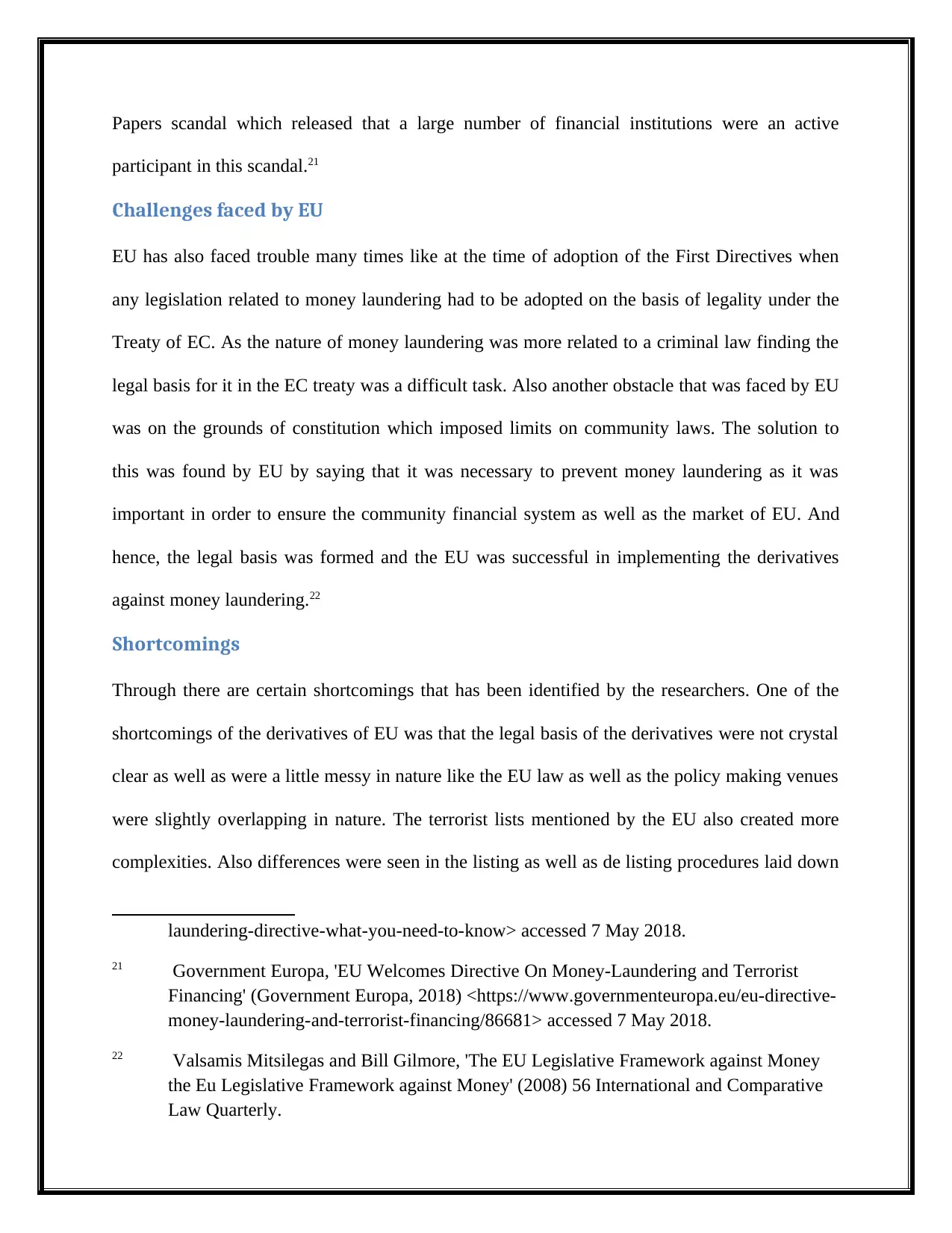
Papers scandal which released that a large number of financial institutions were an active
participant in this scandal.21
Challenges faced by EU
EU has also faced trouble many times like at the time of adoption of the First Directives when
any legislation related to money laundering had to be adopted on the basis of legality under the
Treaty of EC. As the nature of money laundering was more related to a criminal law finding the
legal basis for it in the EC treaty was a difficult task. Also another obstacle that was faced by EU
was on the grounds of constitution which imposed limits on community laws. The solution to
this was found by EU by saying that it was necessary to prevent money laundering as it was
important in order to ensure the community financial system as well as the market of EU. And
hence, the legal basis was formed and the EU was successful in implementing the derivatives
against money laundering.22
Shortcomings
Through there are certain shortcomings that has been identified by the researchers. One of the
shortcomings of the derivatives of EU was that the legal basis of the derivatives were not crystal
clear as well as were a little messy in nature like the EU law as well as the policy making venues
were slightly overlapping in nature. The terrorist lists mentioned by the EU also created more
complexities. Also differences were seen in the listing as well as de listing procedures laid down
laundering-directive-what-you-need-to-know> accessed 7 May 2018.
21 Government Europa, 'EU Welcomes Directive On Money-Laundering and Terrorist
Financing' (Government Europa, 2018) <https://www.governmenteuropa.eu/eu-directive-
money-laundering-and-terrorist-financing/86681> accessed 7 May 2018.
22 Valsamis Mitsilegas and Bill Gilmore, 'The EU Legislative Framework against Money
the Eu Legislative Framework against Money' (2008) 56 International and Comparative
Law Quarterly.
participant in this scandal.21
Challenges faced by EU
EU has also faced trouble many times like at the time of adoption of the First Directives when
any legislation related to money laundering had to be adopted on the basis of legality under the
Treaty of EC. As the nature of money laundering was more related to a criminal law finding the
legal basis for it in the EC treaty was a difficult task. Also another obstacle that was faced by EU
was on the grounds of constitution which imposed limits on community laws. The solution to
this was found by EU by saying that it was necessary to prevent money laundering as it was
important in order to ensure the community financial system as well as the market of EU. And
hence, the legal basis was formed and the EU was successful in implementing the derivatives
against money laundering.22
Shortcomings
Through there are certain shortcomings that has been identified by the researchers. One of the
shortcomings of the derivatives of EU was that the legal basis of the derivatives were not crystal
clear as well as were a little messy in nature like the EU law as well as the policy making venues
were slightly overlapping in nature. The terrorist lists mentioned by the EU also created more
complexities. Also differences were seen in the listing as well as de listing procedures laid down
laundering-directive-what-you-need-to-know> accessed 7 May 2018.
21 Government Europa, 'EU Welcomes Directive On Money-Laundering and Terrorist
Financing' (Government Europa, 2018) <https://www.governmenteuropa.eu/eu-directive-
money-laundering-and-terrorist-financing/86681> accessed 7 May 2018.
22 Valsamis Mitsilegas and Bill Gilmore, 'The EU Legislative Framework against Money
the Eu Legislative Framework against Money' (2008) 56 International and Comparative
Law Quarterly.
⊘ This is a preview!⊘
Do you want full access?
Subscribe today to unlock all pages.

Trusted by 1+ million students worldwide
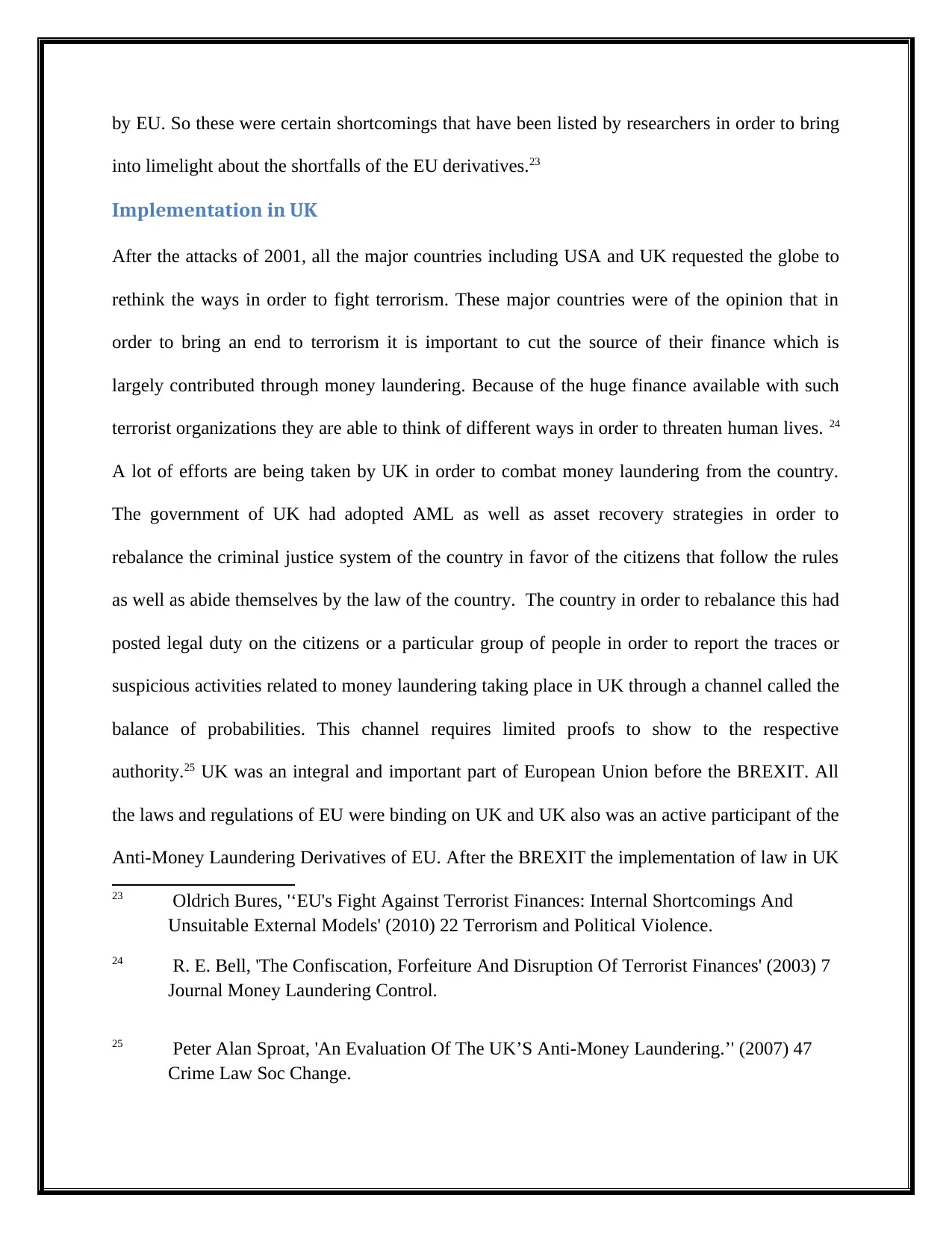
by EU. So these were certain shortcomings that have been listed by researchers in order to bring
into limelight about the shortfalls of the EU derivatives.23
Implementation in UK
After the attacks of 2001, all the major countries including USA and UK requested the globe to
rethink the ways in order to fight terrorism. These major countries were of the opinion that in
order to bring an end to terrorism it is important to cut the source of their finance which is
largely contributed through money laundering. Because of the huge finance available with such
terrorist organizations they are able to think of different ways in order to threaten human lives. 24
A lot of efforts are being taken by UK in order to combat money laundering from the country.
The government of UK had adopted AML as well as asset recovery strategies in order to
rebalance the criminal justice system of the country in favor of the citizens that follow the rules
as well as abide themselves by the law of the country. The country in order to rebalance this had
posted legal duty on the citizens or a particular group of people in order to report the traces or
suspicious activities related to money laundering taking place in UK through a channel called the
balance of probabilities. This channel requires limited proofs to show to the respective
authority.25 UK was an integral and important part of European Union before the BREXIT. All
the laws and regulations of EU were binding on UK and UK also was an active participant of the
Anti-Money Laundering Derivatives of EU. After the BREXIT the implementation of law in UK
23 Oldrich Bures, '‘EU's Fight Against Terrorist Finances: Internal Shortcomings And
Unsuitable External Models' (2010) 22 Terrorism and Political Violence.
24 R. E. Bell, 'The Confiscation, Forfeiture And Disruption Of Terrorist Finances' (2003) 7
Journal Money Laundering Control.
25 Peter Alan Sproat, 'An Evaluation Of The UK’S Anti-Money Laundering.’' (2007) 47
Crime Law Soc Change.
into limelight about the shortfalls of the EU derivatives.23
Implementation in UK
After the attacks of 2001, all the major countries including USA and UK requested the globe to
rethink the ways in order to fight terrorism. These major countries were of the opinion that in
order to bring an end to terrorism it is important to cut the source of their finance which is
largely contributed through money laundering. Because of the huge finance available with such
terrorist organizations they are able to think of different ways in order to threaten human lives. 24
A lot of efforts are being taken by UK in order to combat money laundering from the country.
The government of UK had adopted AML as well as asset recovery strategies in order to
rebalance the criminal justice system of the country in favor of the citizens that follow the rules
as well as abide themselves by the law of the country. The country in order to rebalance this had
posted legal duty on the citizens or a particular group of people in order to report the traces or
suspicious activities related to money laundering taking place in UK through a channel called the
balance of probabilities. This channel requires limited proofs to show to the respective
authority.25 UK was an integral and important part of European Union before the BREXIT. All
the laws and regulations of EU were binding on UK and UK also was an active participant of the
Anti-Money Laundering Derivatives of EU. After the BREXIT the implementation of law in UK
23 Oldrich Bures, '‘EU's Fight Against Terrorist Finances: Internal Shortcomings And
Unsuitable External Models' (2010) 22 Terrorism and Political Violence.
24 R. E. Bell, 'The Confiscation, Forfeiture And Disruption Of Terrorist Finances' (2003) 7
Journal Money Laundering Control.
25 Peter Alan Sproat, 'An Evaluation Of The UK’S Anti-Money Laundering.’' (2007) 47
Crime Law Soc Change.
Paraphrase This Document
Need a fresh take? Get an instant paraphrase of this document with our AI Paraphraser
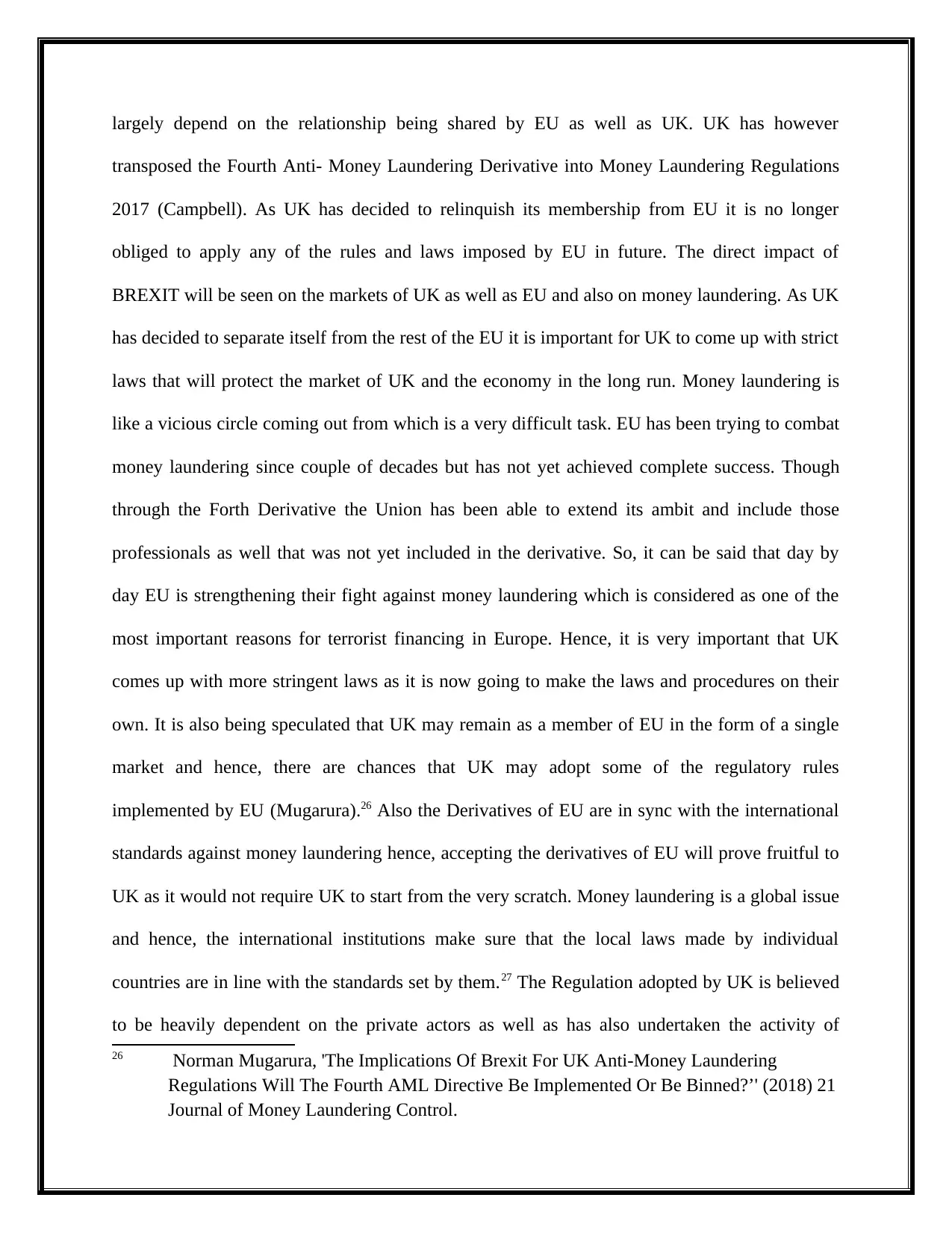
largely depend on the relationship being shared by EU as well as UK. UK has however
transposed the Fourth Anti- Money Laundering Derivative into Money Laundering Regulations
2017 (Campbell). As UK has decided to relinquish its membership from EU it is no longer
obliged to apply any of the rules and laws imposed by EU in future. The direct impact of
BREXIT will be seen on the markets of UK as well as EU and also on money laundering. As UK
has decided to separate itself from the rest of the EU it is important for UK to come up with strict
laws that will protect the market of UK and the economy in the long run. Money laundering is
like a vicious circle coming out from which is a very difficult task. EU has been trying to combat
money laundering since couple of decades but has not yet achieved complete success. Though
through the Forth Derivative the Union has been able to extend its ambit and include those
professionals as well that was not yet included in the derivative. So, it can be said that day by
day EU is strengthening their fight against money laundering which is considered as one of the
most important reasons for terrorist financing in Europe. Hence, it is very important that UK
comes up with more stringent laws as it is now going to make the laws and procedures on their
own. It is also being speculated that UK may remain as a member of EU in the form of a single
market and hence, there are chances that UK may adopt some of the regulatory rules
implemented by EU (Mugarura).26 Also the Derivatives of EU are in sync with the international
standards against money laundering hence, accepting the derivatives of EU will prove fruitful to
UK as it would not require UK to start from the very scratch. Money laundering is a global issue
and hence, the international institutions make sure that the local laws made by individual
countries are in line with the standards set by them.27 The Regulation adopted by UK is believed
to be heavily dependent on the private actors as well as has also undertaken the activity of
26 Norman Mugarura, 'The Implications Of Brexit For UK Anti-Money Laundering
Regulations Will The Fourth AML Directive Be Implemented Or Be Binned?’' (2018) 21
Journal of Money Laundering Control.
transposed the Fourth Anti- Money Laundering Derivative into Money Laundering Regulations
2017 (Campbell). As UK has decided to relinquish its membership from EU it is no longer
obliged to apply any of the rules and laws imposed by EU in future. The direct impact of
BREXIT will be seen on the markets of UK as well as EU and also on money laundering. As UK
has decided to separate itself from the rest of the EU it is important for UK to come up with strict
laws that will protect the market of UK and the economy in the long run. Money laundering is
like a vicious circle coming out from which is a very difficult task. EU has been trying to combat
money laundering since couple of decades but has not yet achieved complete success. Though
through the Forth Derivative the Union has been able to extend its ambit and include those
professionals as well that was not yet included in the derivative. So, it can be said that day by
day EU is strengthening their fight against money laundering which is considered as one of the
most important reasons for terrorist financing in Europe. Hence, it is very important that UK
comes up with more stringent laws as it is now going to make the laws and procedures on their
own. It is also being speculated that UK may remain as a member of EU in the form of a single
market and hence, there are chances that UK may adopt some of the regulatory rules
implemented by EU (Mugarura).26 Also the Derivatives of EU are in sync with the international
standards against money laundering hence, accepting the derivatives of EU will prove fruitful to
UK as it would not require UK to start from the very scratch. Money laundering is a global issue
and hence, the international institutions make sure that the local laws made by individual
countries are in line with the standards set by them.27 The Regulation adopted by UK is believed
to be heavily dependent on the private actors as well as has also undertaken the activity of
26 Norman Mugarura, 'The Implications Of Brexit For UK Anti-Money Laundering
Regulations Will The Fourth AML Directive Be Implemented Or Be Binned?’' (2018) 21
Journal of Money Laundering Control.
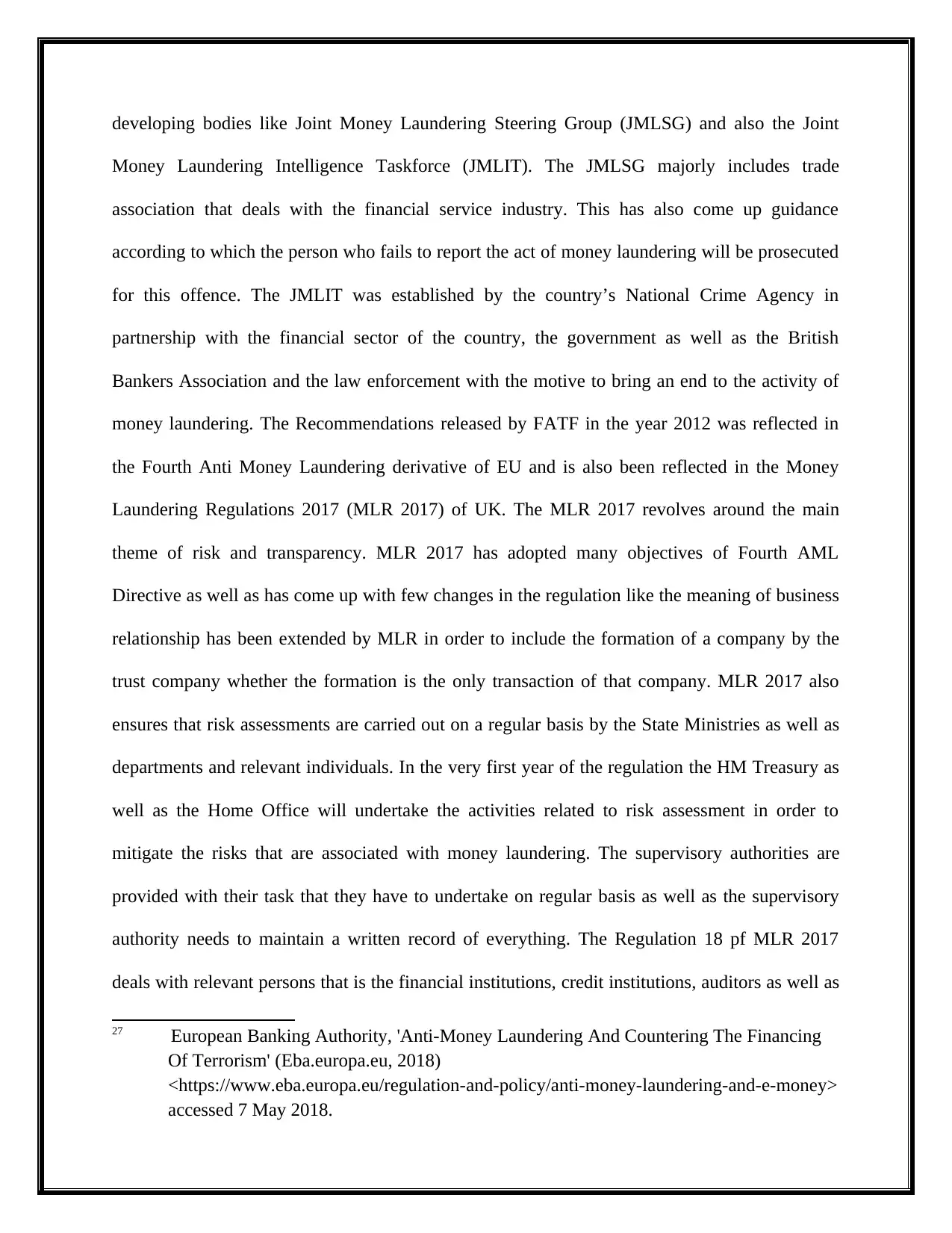
developing bodies like Joint Money Laundering Steering Group (JMLSG) and also the Joint
Money Laundering Intelligence Taskforce (JMLIT). The JMLSG majorly includes trade
association that deals with the financial service industry. This has also come up guidance
according to which the person who fails to report the act of money laundering will be prosecuted
for this offence. The JMLIT was established by the country’s National Crime Agency in
partnership with the financial sector of the country, the government as well as the British
Bankers Association and the law enforcement with the motive to bring an end to the activity of
money laundering. The Recommendations released by FATF in the year 2012 was reflected in
the Fourth Anti Money Laundering derivative of EU and is also been reflected in the Money
Laundering Regulations 2017 (MLR 2017) of UK. The MLR 2017 revolves around the main
theme of risk and transparency. MLR 2017 has adopted many objectives of Fourth AML
Directive as well as has come up with few changes in the regulation like the meaning of business
relationship has been extended by MLR in order to include the formation of a company by the
trust company whether the formation is the only transaction of that company. MLR 2017 also
ensures that risk assessments are carried out on a regular basis by the State Ministries as well as
departments and relevant individuals. In the very first year of the regulation the HM Treasury as
well as the Home Office will undertake the activities related to risk assessment in order to
mitigate the risks that are associated with money laundering. The supervisory authorities are
provided with their task that they have to undertake on regular basis as well as the supervisory
authority needs to maintain a written record of everything. The Regulation 18 pf MLR 2017
deals with relevant persons that is the financial institutions, credit institutions, auditors as well as
27 European Banking Authority, 'Anti-Money Laundering And Countering The Financing
Of Terrorism' (Eba.europa.eu, 2018)
<https://www.eba.europa.eu/regulation-and-policy/anti-money-laundering-and-e-money>
accessed 7 May 2018.
Money Laundering Intelligence Taskforce (JMLIT). The JMLSG majorly includes trade
association that deals with the financial service industry. This has also come up guidance
according to which the person who fails to report the act of money laundering will be prosecuted
for this offence. The JMLIT was established by the country’s National Crime Agency in
partnership with the financial sector of the country, the government as well as the British
Bankers Association and the law enforcement with the motive to bring an end to the activity of
money laundering. The Recommendations released by FATF in the year 2012 was reflected in
the Fourth Anti Money Laundering derivative of EU and is also been reflected in the Money
Laundering Regulations 2017 (MLR 2017) of UK. The MLR 2017 revolves around the main
theme of risk and transparency. MLR 2017 has adopted many objectives of Fourth AML
Directive as well as has come up with few changes in the regulation like the meaning of business
relationship has been extended by MLR in order to include the formation of a company by the
trust company whether the formation is the only transaction of that company. MLR 2017 also
ensures that risk assessments are carried out on a regular basis by the State Ministries as well as
departments and relevant individuals. In the very first year of the regulation the HM Treasury as
well as the Home Office will undertake the activities related to risk assessment in order to
mitigate the risks that are associated with money laundering. The supervisory authorities are
provided with their task that they have to undertake on regular basis as well as the supervisory
authority needs to maintain a written record of everything. The Regulation 18 pf MLR 2017
deals with relevant persons that is the financial institutions, credit institutions, auditors as well as
27 European Banking Authority, 'Anti-Money Laundering And Countering The Financing
Of Terrorism' (Eba.europa.eu, 2018)
<https://www.eba.europa.eu/regulation-and-policy/anti-money-laundering-and-e-money>
accessed 7 May 2018.
⊘ This is a preview!⊘
Do you want full access?
Subscribe today to unlock all pages.

Trusted by 1+ million students worldwide
1 out of 18
Related Documents
Your All-in-One AI-Powered Toolkit for Academic Success.
+13062052269
info@desklib.com
Available 24*7 on WhatsApp / Email
![[object Object]](/_next/static/media/star-bottom.7253800d.svg)
Unlock your academic potential
Copyright © 2020–2025 A2Z Services. All Rights Reserved. Developed and managed by ZUCOL.





